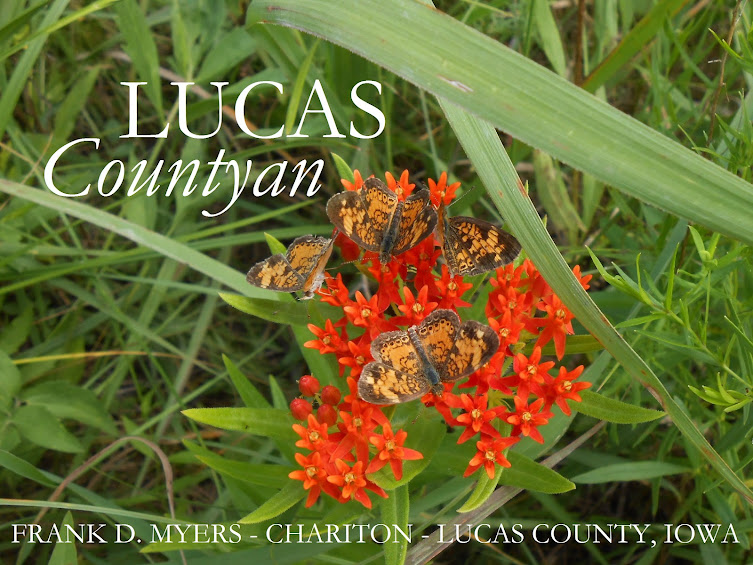Please excuse what's turning into a two-day gap between Tuesday's post about Union Township's Argo and the planned follow-up post about the Fancy Hill Hotel, located at Argo. But I had no idea earlier in the week that Bev (Collins) Snook grew up in the beautiful old farm house (now gone) that was built early in the 20th century just in front of Fancy Hill. So I needed to wait for more information and do a little more scratching around.
I'm thinking I'll come back to Fancy Hill tomorrow.
But I wanted to take a look this morning at a favorite map, the 1855 Mendenhall "Map of Iowa, Exhibiting Townships, Cities, Villages, Post Offices, Railroads, Common Roads & other Improvements."
You can download this map from the Library of Congress, but be warned that if you want to manipulate it --- pull out detail of specific counties, for example --- you're going to need to select the massive TIFF file, then sit for a while as it makes its way through cyberspace to your computer and finally change it to JPEG yourself. The JPEG version available to download is too small.
Ignore the straight black line that passes through Chariton, Osceola, Pisgah and other southern Iowa towns on this map --- that's the projected route of the Burlington & Missouri River Railroad, stalled by the Civil War at Ottumwa and not built westward until 1866-1868.
But you can follow the "common" roads then in use --- and see why the folks living near Argo and Fancy Hill were optimistic about their location in the 1850s. They were living astraddle the gateway to southwest Iowa --- then largely unsettled --- and, eventually, St. Joseph, Missouri --- launching pad for countless journeys west across the Great Plains.
The Mormon Trail entered Lucas County near Greenville Post Office, followed the great ridge dividing Missouri and Mississippi river drainages northwest to Chariton, then swung south along the same ridge through Argo before passing into Clarke County just east of the short-lived post office called Glenn's. Argo's neighboring post office --- Freeland, a Plymate family enterprise --- was just up the trail northeast of Argo, about where the trail crosses the Warren-Whitebreast township line, but was not noted on this map.
Near Glenn's, the old trail split --- one branch heading south to Garden Grove; the other on west through Bartlettville to White Breast. There, the old trail headed northwest to Pisgah while a newer branch headed on to Hopeville, where the utopian Hopewell/Hopeville colony had been founded, before swinging up to Pisgah, established in 1846 as a Mormon way station and still flourishing.
During the 1860s, the Last Chance settlement and post office came into being nearer the Lucas-Clarke county line; and over in Clarke County, Glenn's went out of business but the Smyrna post office was established.
I found a series of advertiement in Burlington newspapers --- then the papers of record for southern Iowa --- placed by the government, seeking private contractors to carry the mail in this rapidly expanding region. Five of these routes involved routes based in Chariton.
One, published Feb. 15, 1854, read as follows: "9423 --- From Chariton, by Argo, Glenn's, Bartlettville, White Breast, and Hopeville, to Pisgah, 56 miles and back, once a week. Leave Chariton Thursday at 12 noon, arrive Pisgah next day by 8 p.m., leave Pisgah Tuesday at 6 a.m., arrive Chariton next day by 12 noon. Proposals to commence at Glenn's are invited; also, to omit Hopeville."
I'm not sure exactly what the contractor was to do with himself between Friday night and the next Tuesday morning, if becalmed in Pisgah for the weekend, but I suppose it's possible he might have combined this route with others and worked something out.
Bids also were sought on other weekly routes to and from Chariton: Chariton via Tallahoma and Osceola to Pisgah and back; Chariton via Newbern and Hammondsburg to Indianola and back; Chariton via Douglas and Lewis to Council Bluffs and back; and Chariton via Corydon and Grand River to Princeton, Missouri, and back.
The mail arrived in Chariton on routes based in Knoxville, Oskaloosa, Albia and Centerville.
Gradually, traffic on the old Mormon Trail diminished, however. One key reason was the direct route from Chariton almost due west via Tallahoma (northeast of Lucas) to Osceola. The main Western Stage Co. route followed this trail and it became the most frequently used.
Then the railroad changed everything. The main B.&M.R. route headed due west to Osceola and beyond, too. And the rail route southwest out of Chariton that offered connections to St. Joseph, commencing in the early 1870s, passed to the southeast of Argo and Fancy Hill through that upstart town named Derby. Gradually all of the settlements and post offices along the old trail in Lucas and Clarke counties, other than Chariton, faded and died.
A couple of other things to notice on the map --- The road in northern Wayne County connecting Bethlehem and Cambria was the Mormon Trail's "middle route," used most frequently after 1849 by Saints and many others headed west.
And I was interested to note the Hungarian settlement near New Buda in Decatur County. You can read, if you like, more about New Buda here.
But you can follow the "common" roads then in use --- and see why the folks living near Argo and Fancy Hill were optimistic about their location in the 1850s. They were living astraddle the gateway to southwest Iowa --- then largely unsettled --- and, eventually, St. Joseph, Missouri --- launching pad for countless journeys west across the Great Plains.
The Mormon Trail entered Lucas County near Greenville Post Office, followed the great ridge dividing Missouri and Mississippi river drainages northwest to Chariton, then swung south along the same ridge through Argo before passing into Clarke County just east of the short-lived post office called Glenn's. Argo's neighboring post office --- Freeland, a Plymate family enterprise --- was just up the trail northeast of Argo, about where the trail crosses the Warren-Whitebreast township line, but was not noted on this map.
Near Glenn's, the old trail split --- one branch heading south to Garden Grove; the other on west through Bartlettville to White Breast. There, the old trail headed northwest to Pisgah while a newer branch headed on to Hopeville, where the utopian Hopewell/Hopeville colony had been founded, before swinging up to Pisgah, established in 1846 as a Mormon way station and still flourishing.
During the 1860s, the Last Chance settlement and post office came into being nearer the Lucas-Clarke county line; and over in Clarke County, Glenn's went out of business but the Smyrna post office was established.
I found a series of advertiement in Burlington newspapers --- then the papers of record for southern Iowa --- placed by the government, seeking private contractors to carry the mail in this rapidly expanding region. Five of these routes involved routes based in Chariton.
One, published Feb. 15, 1854, read as follows: "9423 --- From Chariton, by Argo, Glenn's, Bartlettville, White Breast, and Hopeville, to Pisgah, 56 miles and back, once a week. Leave Chariton Thursday at 12 noon, arrive Pisgah next day by 8 p.m., leave Pisgah Tuesday at 6 a.m., arrive Chariton next day by 12 noon. Proposals to commence at Glenn's are invited; also, to omit Hopeville."
I'm not sure exactly what the contractor was to do with himself between Friday night and the next Tuesday morning, if becalmed in Pisgah for the weekend, but I suppose it's possible he might have combined this route with others and worked something out.
Bids also were sought on other weekly routes to and from Chariton: Chariton via Tallahoma and Osceola to Pisgah and back; Chariton via Newbern and Hammondsburg to Indianola and back; Chariton via Douglas and Lewis to Council Bluffs and back; and Chariton via Corydon and Grand River to Princeton, Missouri, and back.
The mail arrived in Chariton on routes based in Knoxville, Oskaloosa, Albia and Centerville.
Gradually, traffic on the old Mormon Trail diminished, however. One key reason was the direct route from Chariton almost due west via Tallahoma (northeast of Lucas) to Osceola. The main Western Stage Co. route followed this trail and it became the most frequently used.
Then the railroad changed everything. The main B.&M.R. route headed due west to Osceola and beyond, too. And the rail route southwest out of Chariton that offered connections to St. Joseph, commencing in the early 1870s, passed to the southeast of Argo and Fancy Hill through that upstart town named Derby. Gradually all of the settlements and post offices along the old trail in Lucas and Clarke counties, other than Chariton, faded and died.
A couple of other things to notice on the map --- The road in northern Wayne County connecting Bethlehem and Cambria was the Mormon Trail's "middle route," used most frequently after 1849 by Saints and many others headed west.
And I was interested to note the Hungarian settlement near New Buda in Decatur County. You can read, if you like, more about New Buda here.



































